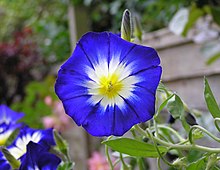You are here
Species
Convolvulus
IUCN
NCBI
EOL Text
Annual or perennial herbs with erect, prostrate or twining stems. Leaves variable, entire or lobed. Flowers axillary in 1-flowered cymes, sometimes subumbellate. Sepals 5, equal or subequal. Corolla funnel-shaped, white, pink or pinkish-purple, shallowly 5-lobed. Stamens 5, included. Ovary 2-locular. Style 1, simple, filiform; stigmas 2, linear, about the same thickness as the styles, filiform. Capsule usually 4-valved. Seeds usually 4, black or brown, usually glabrous.
| License | http://creativecommons.org/licenses/by-nc/3.0/ |
| Rights holder/Author | Mark Hyde, Bart Wursten, Petra Ballings, Flora of Zimbabwe |
| Source | http://www.zimbabweflora.co.zw/speciesdata/genus.php?genus_id=1180 |
Convolvulus
Hierbas erectas o postradas, arbustos o bejucos volubles. Hojas alternas, pecioladas; láminas simples, enteras o lobadas; estípulas ausentes. Flores bisexuales, actinomorfas, solitarias o agregadas en cabezuelas involúcrales. Cáliz con 5 sépalos iguales o desiguales; corola campanulada o infundibuliforme, el limbo levemente 5-lobado; estambres 5, exertos; ovario súpero, con estilo solitario y 2 estigmas filiformes. Frutos un cápsula, 4-valvada, con cada una de las valvas abriendo en dos; semillas 4 por fruto, con dos lados planos y uno convexo. Género con alrededor de 250 especies, en su mayoría nativas del Viejo Mundo.
Convolvulus
Erect or prostrate herbs, shrubs, or twining vines. Leaves alternate, petiolate; blades simple, entire or lobed; stipules absent. Flowers bisexual, actinomorphic, solitary or clustered in involucrate heads. Calyx of 5 equal or unequal sepals; corolla campanulate or infundibuliform, the limb slightly 5-lobed; stamens 5, exserted; ovary superior, with a solitary style and 2 filiform stigmas. Fruit a 4-valvate capsule, with each of the valves opening in two; seeds 4 per fruit, with two sides flat and one convex. A genus of about 250 species, mostly native to the Old World.
Barcode of Life Data Systems (BOLD) Stats
Specimen Records:232
Specimens with Sequences:336
Specimens with Barcodes:278
Species:110
Species With Barcodes:110
Public Records:99
Public Species:60
Public BINs:0
Convolvulus /kənˈvɒlvjuːləs/[1] is a genus of about 200[2] to 250[3][4] species of flowering plants in the bindweed family Convolvulaceae, with a cosmopolitan distribution. Common names include bindweed and morning glory, both names shared with other closely related genera.
They are annual or perennial herbaceous vines, bines and (a few species of) woody shrubs, growing to 0.3–3 m tall. The leaves are spirally arranged, and the flowers trumpet-shaped, mostly white or pink, but blue, violet, purple or yellow in some species.
Many of the species are problematic weeds, which can swamp other more valuable plants by climbing over them, but some are also cultivated for their attractive flowers. Some species are globally threatened.
Convolvulus species are used as food plants by the larvae of some Lepidoptera species, including the sweet potato leaf miner (Bedellia somnulentella) and The Gem. The leaf miner Bucculatrix cantabricella feeds exclusively on C. cantabricus.
- Convolvulus acanthocladus
- Convolvulus aitchisonii
- Convolvulus althaeoides – mallow bindweed, mallow-leaf bindweed
- Convolvulus ammannii
- Convolvulus angustissimus
- Convolvulus arvensis – lesser bindweed, field bindweed, common bindweed, white convolvulus, creeping jenny, perennial morning glory
- Convolvulus assyricus
- Convolvulus betonicifolius
- Convolvulus boissieri
- Convolvulus calvertii
- Convolvulus canariensis
- Convolvulus cantabrica
- Convolvulus capensis
- Convolvulus carrii
- Convolvulus cataonnicus
- Convolvulus cephalopodus
- Convolvulus chilensis
- Convolvulus cneorum – shrubby bindweed, silvery bindweed, silverbush
- Convolvulus compactus
- Convolvulus divaricatus
- Convolvulus dorycnium
- Convolvulus equitans – grey bindweed, Texas bindweed
- Convolvulus erinaceus
- Convolvulus erubescens – blushing bindweed, pink bindweed, Australian bindweed
- Convolvulus eyreanus
- Convolvulus floridus – guadil, morning-glory-tree, rhodium-wood
- Convolvulus fractosaxosa
- Convolvulus fruticosus
- Convolvulus glomeratus
- Convolvulus gortschakovii
- Convolvulus graminetinus
- Convolvulus hermanniae
- Convolvulus holosericeus
- Convolvulus humilis
- Convolvulus kotschyanus
- Convolvulus lanatus
- Convolvulus leiocalycinus
- Convolvulus lineatus
- Convolvulus mauritanicus – African bindweed, synonym for Convolvulus sabatius
- Convolvulus nodiflorus – aguinaldo blanco
- Convolvulus nyctagineus
- Convolvulus ocellatus
- Convolvulus oleifolius
- Convolvulus pentapetaloides
- Convolvulus persicus
- Convolvulus phrygius
- Convolvulus pilosellifolius – soft bindweed
- Convolvulus prostratus
- Convolvulus pseudocantabricus
- Convolvulus pyrrhotrichus
- Convolvulus remotus
- Convolvulus rhyniospermus
- Convolvulus rottlerianus
- Convolvulus sabatius – blue rock bindweed,[8] ground blue-convolvulus
- Convolvulus scammonia – scammony
- Convolvulus scindicus
- Convolvulus scoparius – lignum rhodium, rhodium-wood
- Convolvulus simulans
- Convolvulus spinosus
- Convolvulus steppicola
- Convolvulus stocksii
- Convolvulus suffruticosus
- Convolvulus trabutianus
- Convolvulus tragacanthoides
- Convolvulus tricolor – dwarf convolvulus, dwarf morning glory
- Convolvulus valentinus
- Convolvulus virgatus
- Convolvulus waitaha
- Convolvulus wallichianus – Wallich's bindweed
References[edit]
- ^ Sunset Western Garden Book. 1995. 606–07.
- ^ Carine, M. A. and L. Robba. (2010). Taxonomy and evolution of the Convolvulus sabatius complex (Convolvulaceae). Phytotaxa 14 1.
- ^ a b Convolvulus. Flora of China.
- ^ Convolvulus. The Jepson eFlora 2013.
- ^ GRIN Species Records of Convolvulus. Germplasm Resources Information Network (GRIN).
- ^ Convolvulus. Integrated Taxonomic Information System (ITIS).
- ^ Convolvulus species list. Flora of Pakistan.
- ^ Convolvulus sabatius. Royal Horticultural Society.
| License | http://creativecommons.org/licenses/by-sa/3.0/ |
| Rights holder/Author | Wikipedia |
| Source | http://en.wikipedia.org/w/index.php?title=Convolvulus&oldid=640656126 |
Like the genus Ipomoea, this genus contains species which are significant agricultural weeds but which are also sometimes cultivated as ornamental purposes.
| License | http://creativecommons.org/licenses/by/3.0/ |
| Rights holder/Author | Amy Chang, Amy Chang |
| Source | No source database. |



